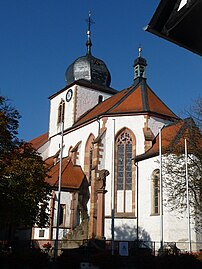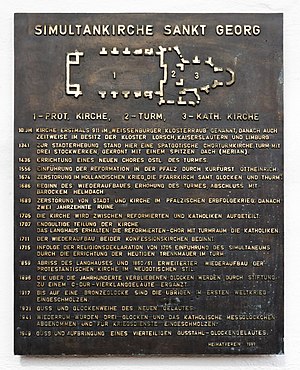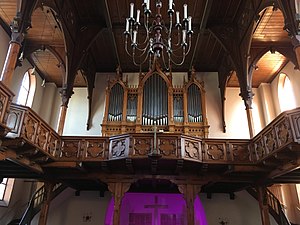St. Georg (Wachenheim)
|
Church of St. Georg in Wachenheim |
|
| Basic data | |
| Denomination | Protestant |
| place | Wachenheim an der Weinstrasse, Germany |
| Building history | |
| construction time | 12th century - 1859 |
| Building description | |
| Architectural style | Gothic |
| Furnishing style | Choir, side chapel, sacristy, nave |
| Construction type | module |
| 49 ° 26 '18.2 " N , 8 ° 10' 53.6" E | |
The church of St. Georg in the historic center of Wachenheim an der Weinstrasse is, along with the ruins of Wachtenburg, the town's landmark. Since the beginning of the 18th century, the church has been used as a simultaneous church by Catholics and Protestants.
history
The existence of a parish in Wachenheim is believed to have existed since the 9th century. The first written mention of the church dates from 911. The church is called in the "Weissenburger Klosterraub" and is temporarily owned by the monasteries Lorsch , Kaiserslautern and Limburg .
In 1341 Wachenheim received city rights . A late Gothic choir tower church with a three-story tower and a pointed roof is known from a Merian engraving .
Around 1360 (depending on the source also 1436) a new choir was built east of the tower.
After the destruction of the Limburg monastery , its abbot Machar Wais von Fauerbach († 1509) moved to the Münzhof Wachenheim from 1504 and wanted to relocate the abbey here. In 1508 he therefore acquired the Wachenheim St. George Church from the Premonstratensians in Kaiserslautern in order to make it the future abbey church. The project came to a halt when the abbot died. However, he was buried in the choir of the local church.
The Speyer cathedral capitular and archdeacon Johann Kranich von Kirchheim († 1534) donated three annual memorials for himself and his parents in the parish church of St. Georg on February 23, 1530 , as his family's hereditary funeral is located there. The commemorations were set for September 17th (anniversary of the father's death), March 7th (anniversary of the mother's death) and for his own death anniversary. On the Sunday before they were supposed to be announced to the faithful by the local priest in the pulpit and the Wachenheim bell ringer was obliged to “put a bar on the big sarck , including my father blessed buried , over which a black cloth from Schechter and uff the same a black gulden stucco and four burning candles, adventure to the vigils and in the morning to the gothic amptern ” .
The Reformation began to take effect in Wachenheim from around 1550 , and Elector Ottheinrich introduced the Reformation in the Palatinate in 1556 . In 1674 the building was destroyed in the Dutch War and was not rebuilt until 1686. In 1689 the town, the Wachtenburg and the church are destroyed in the Palatinate War of Succession .
From 1705 Reformed and Catholics shared the building. In 1707 the church was finally divided. The Reformed keep the nave, while the Catholics keep the choir and the tower building. Since then the church has been used as a simultaneous church.
In 1711 the church was rebuilt. In 1715 the dividing wall was erected to separate the choir and tower from the nave. In 1859 the nave was torn down and then rebuilt in the neo-Gothic style . In 1896 the chime was added to a C major four-tone chime. The bells are removed and melted down in each of the two world wars. Since 1949 there has been a four-part cast steel bell ringing again.
organ
The Protestant church in Wachenheim has a Voit organ from 1883. It was restored by organ builder G. Owart (Neuhofen) in 1974. The organ has 23 stops on two manuals.
Web links
Individual evidence
- ^ Franz Xaver Remling : Documented history of the former abbeys and monasteries in what is now Rhine Bavaria , Volume 1, p. 141, Neustadt an der Haardt, 1836; (Digital scan)
- ↑ Konrad von Busch and Franz Xaver Glasschröder: Choir Rules and Younger Sea Book of the Old Speyer Cathedral Chapter , Speyer 1923, pages 276 and 277
- ^ Franz Xaver Glasschröder : Documents on the Palatinate Church History in the Middle Ages , Munich, 1903, page 172, document regist no. 409



